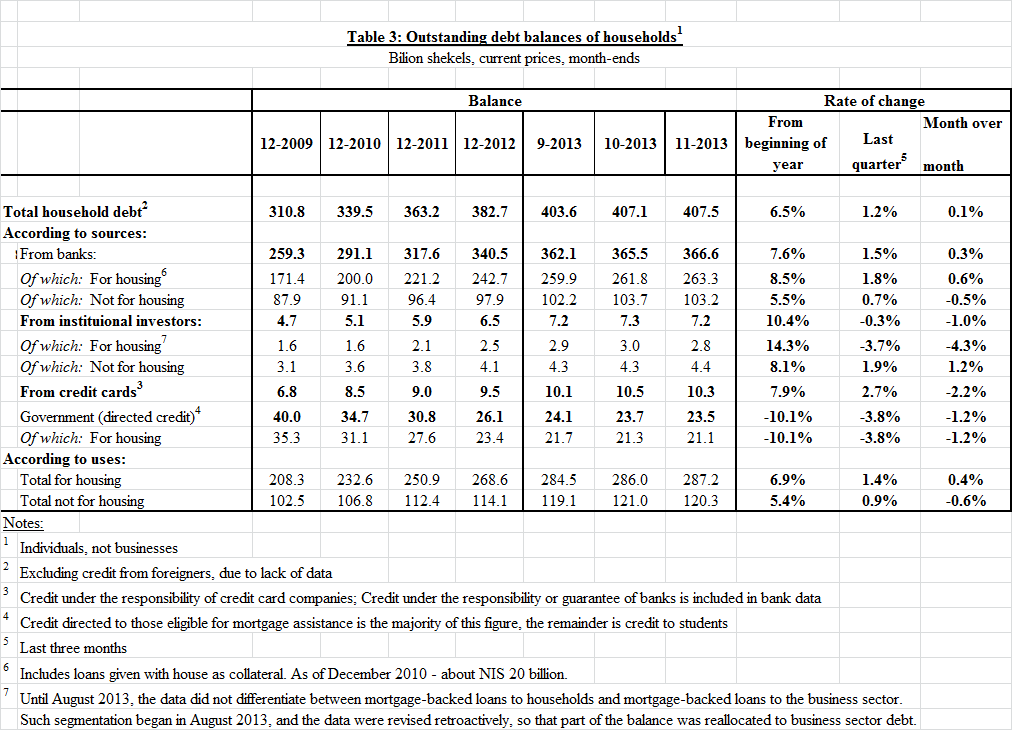Debt Developments in the Economy, November–December 2013
Business sector debt increased by 0.6 percent in November, to around NIS 783 billion. Household debt increased by about NIS 0.4 billion (0.1 percent) to around NIS 407 billion at the end of the month.
 To view this press release as a Word document
To view this press release as a Word document
 Graphs&Data
Graphs&Data
Business sector debt increased by 0.6 percent in November, to around NIS 783 billion. Household debt increased by about NIS 0.4 billion (0.1 percent) to around NIS 407 billion at the end of the month.
The business sector’s outstanding debt
- The total outstanding debt of the business sector increased by about NIS 4.4 billion (0.6 percent) to around NIS 783 billion in November. The increase derived from net raising of debt, mostly from the banks (about NIS 4.1 billion) and via tradable bonds (about NIS 1 billion). The increase was partially offset as a result of the decline in the Consumer Price Index, which decreased the outstanding CPI indexed debt.
- In December, the business sector (excluding banks and insurance companies) issued about NIS 3.1 billion in bonds, all of which were tradable bonds. This is higher than the monthly average for the year to date, of about NIS 2.5 billion. In total over the year, about NIS 30 billion were raised, about NIS 2 billion more than in 2012.



Household debt
- Households’ outstanding debt in November was about NIS 407 billion. The balance of housing debt, which is included in total household debt, increased by about NIS 1.2 billion (0.4 percent), to around NIS 287 billion at the end of November.
- In December, new mortgages taken out totaled about NIS 4.7 billion, higher than the monthly average since the beginning of the year of about NIS 4.3 billion. In total over the year, new mortgages taken out in 2013 totaled about NIS 51.7 billion.


The cost of the debt
- In November, the yield spread in the unindexed track increased slightly from the previous month by about 0.03 percentage points, as a result of the decline in interest on credit balances.
- In the CPI-indexed track, the spread between the interest rate on new bank credit granted and the interest rate on deposits increased in November by about 0.09 percentage points, due to an increase in the interest rate on credit and a decline in the interest rate on deposits.
- At the end of November, the spread between the yield on indexed corporate bonds—measured by the Tel Bond 60—and average yields on indexed government bonds was 1.23 percentage points, similar to the spread at the end of October. Since December 2012, the spread has narrowed by abound 0.5 percentage points.
- In December, the average interest rate on new unindexed mortgages declined by around 0.05 percentage points.
- The interest rate on new CPI-indexed mortgages declined by around 0.04 percentage points, following increases in the interest rate in previous months.




For links to Data and Statistics on the Bank of Israel website:
http://www.boi.org.il/en/bankingsupervision/data/pages/tables.aspx?chapterid=13
![]() To view this press release as a Word document
To view this press release as a Word document







